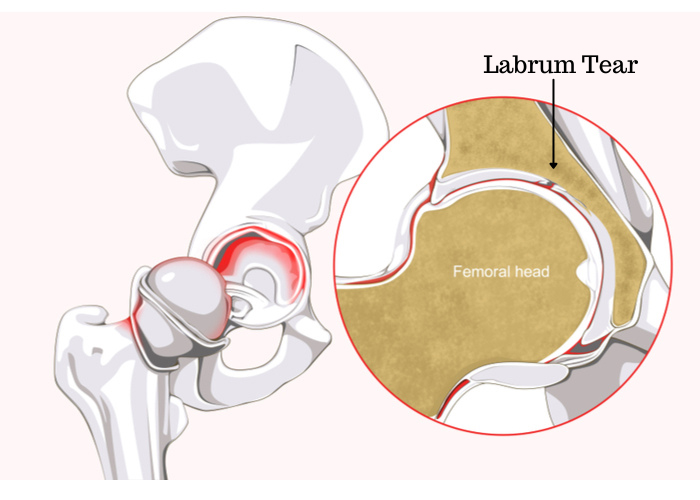Hip Labral Tear Surgeon
A hip labrum tear is often the injured, innocent bystander of an underlying problem in the hip. That problem can often be hip impingement also called femoroacetabular impingement or FAI. If you do not correct the underlying problem, the labrum will be unable to heal. Hip labrum and hip labral tear specialist, Doctor Prem Ramkumar, has the training and experience to correct a labrum tear by finding the underlying problem causing the issue. He is located in Long Beach and serves patients in Los Angeles, Orange County, and surrounding Southern California areas. Contact Dr. Ramkumar’s office today!

What is the hip labrum and how does it tear?
The ball and socket joint that makes up the hip allows you to walk, run, jump, and climb stairs. The hip labrum is a protective layer of soft tissue found on the rim of the hip joint. The labrum giving you the full range of motion and stability by acting as a rubber seal, holding the ball at the top of the femur (thigh bone) to keep it inside the hip socket. Additionally, it protects the precious articular cartilage surface.
The labrum is a complex structure that merges with the bony rim of the acetabulum on one side and the articular cartilage of the acetabular socket on the other. The anterosuperior fibers of the labrum are oriented parallel to the rim and are thus less resistant to shear stresses and can tear more readily in the setting of instability or impingement. Conversely, the posterior fibers of the labrum are oriented perpendicular to the rim and are less likely to tear under shear stresses. Interestingly, embryological studies reveal that when we are born the anterior labrum extends between the femoral head and acetabulum but with time and motion, this extension “wears” away. When this labrum experiences excessive force as an adult, the articular cartilage is at risk and can lead to osteoarthritis.
Although non-hip specialists focus on the labral tear as a cause of symptoms, Dr. Ramkumar and others who specialize in the hip understand that the labrum is often the injured innocent bystander of an underlying problem. Most commonly, the underlying problem is impingement (femoroacetabular impingement or hip impingement), dysplasia, or instability from a rotational (or version) or anatomic variation. Dr. Ramkumar uses a comprehensive history, examination, and imaging evaluation to characterize the underlying cause of your labral tear to ensure that the cause of the torn labrum is addressed – rather than just repairing the labrum and being later surprised when it re-tears after failing to address the underlying bony anatomic variation. When it comes to tears of the hip labrum, it is important to not miss the forest (underlying bony issue) for the trees (labral tear).

What is a hip labrum repair?
A tear of the hip labrum can be quite painful, causing catching, clicking, and sharp pain when changing body positions. At the time of addressing the underlying cause, typically hip impingement or dysplasia, the hip labrum is important be repair to help eliminate pain and restore joint stability. Historically, surgeons used to debride or remove the labrum and this correlated with poor outcomes. Now that our understanding and technologies have advanced, labral repair or preservation is foundational to hip preservation. Dr. Prem Ramkumar, hip labrum repair surgeon, is located in Long Beach and serves patients in Los Angeles, Orange County, and surrounding Southern California areas.
Who is a candidate for a hip labrum repair?
If your hip labral tear is extensive or you remain in pain after trying conservative treatments, you may be a candidate for an arthroscopic hip labrum repair in the setting of addressing femoroacetabular impingement or borderline dysplasia. FAI is when bony malformations appear on the femoral head, resulting in what should be a spherical head to function as a square peg in the round hole that is the acetabular socket. Patients with FAI typically have a history of being young and athletic as an adolescent and young adult. Dr. Ramkumar will often remove the underlying bony issue during hip labrum repair surgery.
How is a hip labrum repair performed?
A hip labrum repair is an outpatient procedure performed arthroscopically. Dr. Ramkumar makes small incisions in the hip joint and then inserts a tiny camera to see inside the joint. He then places small instruments into the joint to repair the labrum, using the image from the camera as a guide. The goal of the hip labrum repair is to reattach the torn labrum to the acetabulum (the socket in the pelvis) to restore the seal around the hip joint and reduce pain.
Some labral tears are large and may not be repairable. In this case, Dr. Ramkumar may perform a labral reconstruction or labral debridement. During this procedure, a graft from either the patient (autograft) or a donor (allograft) will be used to rebuild the labrum and restore function to the joint.
What is the recovery time from a hip labrum repair?
Recovery time from a hip labrum repair varies from person to person and often depends on the complexity of the surgery. Typically, a labrum reconstruction will take longer to heal than a hip labrum repair. You will be on crutches for about two weeks after surgery and can gradually put weight on your leg. By four weeks you should be walking normally. You will undergo extensive physical therapy to regain normal hip function and strength. Full recovery generally takes most athletes about 6-8 months.

